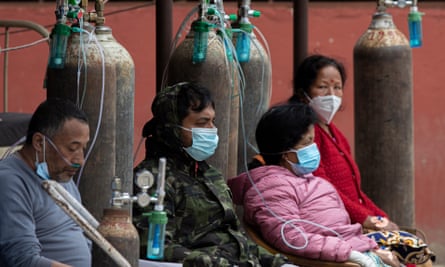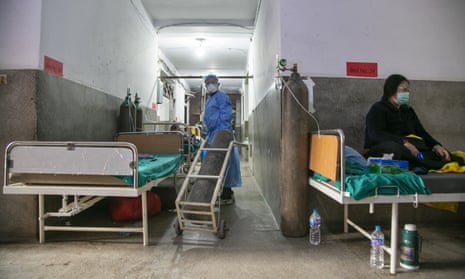The story of Dilli Raj Joshi is now a sadly familiar one. After travelling to a wedding in mid-April with his family – a fun, rowdy affair – he began to be troubled by a headache and then breathing difficulties.
Joshi’s worried family took him to a nearby hospital, where he was diagnosed with Covid-19 and pneumonia. As his condition deteriorated, the doctors suggested he be transferred to a hospital with intensive care unit (ICU) beds and ventilators, as they had none. But though the family frantically searched for three days, no ICU ward had any space for Joshi. On Friday he died, having never received the medical care he needed to live.
“If we had found one ICU bed or a ventilator, he would have survived,” said his brother, Lekh Raj Joshi. “We tried our best, inquired in nearby districts, called all the politicians I know but we couldn’t save him.”
Similar accounts have dominated Indian media over the past few weeks as a devastating coronavirus second wave has brought the country and its healthcare system to its knees. But this story isn’t from India. Joshi died in north-west Nepal.
Indeed, the terrible scenes that have emerged from India are being repeated across Nepal, a country with high poverty levels that shares a porous border with five Indian states. As India has battled its deadly second wave, thousands have continued to cross over into Nepal – many, it is feared, bringing the virus and its contagious variants that have emerged in India with them. A further 400,000 migrant workers are expected to cross back over but officials have struggled to screen and enforce quarantine for such large numbers.
To Nepal’s north, China said on Monday it would set up a “separation line” on the peak of Mount Everest to prevent the spread of infection from climbers. About 30 people have recently been evacuated from Everest base camp in Nepal after showing Covid-19 symptoms.
Many fear it is already too late for the country. The Covid positivity rate is at 47%, one of the highest in the world, and cases have surged by 1,200% in recent weeks. On Monday, Nepal recorded another 8,777 cases, bringing the total to 394,667.
In the capital, Kathmandu, ICU beds are full, Covid wards are at capacity and, in scenes reminiscent of Delhi, many are dying because they cannot get oxygen. Across Nepal there is a severe shortage of oxygen, with some mid-size cities having no oxygen at all in any of their hospitals.

Dr Ram Kumar Shrestha from Karuna hospital in Kathmandu said it had stopped accepting any more patients because the wards were full and it kept running out of oxygen, putting 35 Covid-19 patients who are on high-flow oxygen at risk of death at any time.
“We had oxygen in stock for just one hour, we tried our best and we couldn’t find more, that’s why we stopped taking new patients,” said Shrestha.
He added: “The longest duration that I have slept is for 15 minutes in the last three days; managing oxygen has been extremely difficult. Almost all private hospitals are facing the same situation in the last four days in Kathmandu.”
Sushila Mishra Bhatt, the deputy mayor at the Dhangadhi sub-metropolitan city, said the situation was also critical in remote far-western Nepal. “There is a shortage of oxygen, there are no beds, no ventilators. Doctors are looking at patients in the corridors and in tents,” she said.
Christie Getman, the Nepal country director for the Mercy Corps NGO, said that in the city of Dhangadhi, bordering the Indian state of Uttar Pradesh, they had recently attempted to locate oxygen for someone with Covid-19 symptoms and had been told there was “no oxygen in the city and the hospitals are at capacity”.
Getman said that in the remote rural areas along the Karnali river basin, in west Nepal, there were only small health clinics with no Covid testing capacity. “We also have staff up in the mountains and there’s almost no health infrastructure there so these areas are not prepared,” she said.
“Everyone’s scrambling, it happened so fast,” added Getman. “Our fear is that it will overwhelm the healthcare system. Already the hospital beds in Kathmandu are full and you certainly couldn’t procure an oxygen canister or even an oximeter if you needed to.”
Gaurab Sharda, the chair of the Nepal oxygen gas manufacturers association, said the oxygen demand had increased fivefold and that even though production was at full capacity, it was not enough.
“The hospitals that were demanding 20 cylinders a day are now demanding 110 cylinders. The cylinders that used to be refilled in four to five days are being sent back the same day for refilling,” Sharda said. “Though we are producing 8,000 cylinders per day, the demand is still high.”
Although Nepal’s prime minister, KP Sharma Oli, has said the Covid-19 situation is “under control” in Nepal, government officials told a very different story.
“I am in a hopeless situation: if somebody asks for a bed, or an oxygen or a ventilator, I don’t have an answer,” an official from the ministry of health and population said, requesting anonymity.

Oxygen manufacturers said they had warned the government a month ago that shortages were imminent if a second wave hit hard like in India, but no preparation was done to increase Nepal’s oxygen capacity. To meet the demand, Nepal is bringing oxygen cylinders from China.
“We have a shortage of 20,000 to 25,000 oxygen cylinders,” said Dr Samir Adhikari, the joint spokesperson of the ministry of health and population. “The situation is out of control … we have shortages of oxygens, beds, ventilators, and it’s difficult to manage.”
Gagan Thapa, a member of the House of Representatives and a former health minister, said Oli had misled the international community about the severity of Nepal’s situation.
“He missed an opportunity to ask for support from the international community and now the situation in Nepal is such that the whole system could crash any time,” Thapa said.
Residents of Kathmandu were equally scathing of Oli’s assurances. “How could the prime minister say it’s under control when it took me three days to find a hospital bed,” said Baburaja Maharjan, whose brother-in-law needed hospital treatment in Kathmandu when his oxygen levels dropped.
Nepal’s crematoriums are being pushed to their limits. The electric crematorium near Kathmandu’s Pashupatinath temple has expanded on to new ground near the banks of the Bagmati River.
Nepal’s army, which has been tasked with managing the dead bodies of Covid victims, said the number of cremations had increased significantly in the past week, with about 100 bodies a day.
“One hundred and twenty-seven bodies were managed in Nepal on Saturday, 74 alone in the Kathmandu Valley,” said the army spokesperson Brig Gen Shantosh Ballave Poudyal over the weekend.
The system has become so overburdened that many families now have to wait 24 hours to cremate or bury their loved ones. And even then, with bodies handled by the military, traditional funerals have become impossible.
Standing in the queue waiting to bury her grandfather, who had died from Covid, Sandhya Sitaula spoke of her sadness that the family could not say goodbye “as per our culture”.
“We couldn’t touch or see him,” said Sitaula. “It was all done by the army.”
